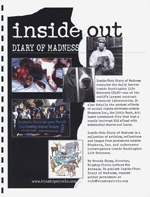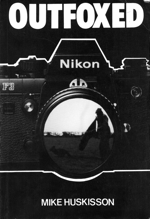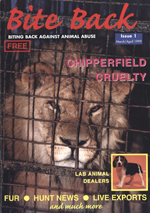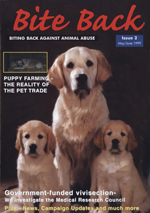The Archives
-
Periodicals
Bite Back (U.K.) #1&2
04.07.15 | PermalinkBite Back – Issues 1-2 (1999, Bristol, England)
One of at least four publications to share the same moniker, this version of Bite Back came into being at the turn of the century. Glossy, full magazine sized, and free, Bite Back was a wonderful tool for reporting on the exciting campaigns of its era. Anyone interested in pressure campaigning will enjoy the brief articles, updates, and images from Hillgrove, Shamrock, Regal Rabbits, and Huntingdon Death Sciences.
We have very little information about this publication and do not know if there were subsequent issues. If you have more information please contact us HERE.
…
-
Most Popular, No Compromise, Periodicals
No Compromise: The Final Two Issues
05.13.13 | PermalinkNo Compromise #29-30 (2006. Santa Cruz / San Francisco, CA)
The early days of my activism were so exciting. After a lifetime of feeling powerless I suddenly discovered that there was a community dedicated to fighting the good fight. Its members were in every major city and many smaller ones, and sometimes not living in any city at all, but in trees and encampments. The people involved were empowered to act for themselves in order to create a better world, and had abandoned all the false hope of political parties and their dead politics. Words meant little, action was what counted, and the sky was the limit. The internet was not yet in wide use, and thank goodness! That meant that we met each other in conference rooms, in squats, on the streets, and sometimes on the pages of No Compromise magazine.
No Compromise shaped who I am today. Each new issue contained articles that helped me and thousands of others to evolve our own style of resistance, and as our experience grew we were able to share our stories in the pages of the magazine.
After 30 issues, the steering committee of No Compromise decided to stop publishing in 2006. Their decision could not have come at a worse time. With the SHAC website and newsletter killed by the convictions of the SHAC 7, Bite Back being published only sporadically and with a limited focus, and the Earth First! Journal mired in its “Confronting Oppression Within” drama, the sudden absence of No Compromise meant that the primary sources for radical animal liberation news, opinion, and strategy were the twin sewers of online social networks and the North American Animal Liberation Press Office. These were dark times for our movement, and we are only just beginning to recover.
The final issues of No Compromise were the best of the series, though! I was in prison when issue 30 was released, and it felt electric in my hands. I read it over and over, alternately laughing and crying. As I was putting this post together I decided to pull out that print copy. It gave me the same sense of awe I had when I read those first issues. More than that, it reminded me that there is still a community of people capable of changing the world through compassionate direct action and mutual aid. And you know what? We are going to win!
KEEP FIGHTING,
Josh Harper(The complete set of all past issues of No Compromise can be found HERE)
…
-
One-off publications
Inside / Out: Diary of Madness
05.08.12 | PermalinkInside / Out: Diary of Madness (2001, St. Louis, MO)
Back when the United States still had a strong grassroots animal liberation infrastructure, activists would regularly travel from all across the country to attend national demonstrations. Hundreds, or even thousands, of people would descend on various targets, and for a few days at least, bring the killers a little taste of the hell that they regularly created for non-humans.
Inside / Out is the story of Brenda Shoss’ experience at one such demonstration which took place in Little Rock between October 27th and 29th in 2001. Brenda, a devoted animal rescuer and mother, represented the broad diversity of the campaign against Huntingdon Life Sciences during it’s early years. Hailing from St. Louis, she hardly fit the image of “the usual suspects” in militant campaigning. Happily marching alongside pierced punks and anarchists, Brenda’s mild mannered and patriotic politics did not clash with those held by her comrades: instead her presence signaled a movement able to break through to a wider audience. Throughout her account of the demonstrations she evokes the anger and outrage that prompted thousands to band together, despite their differences, to fight to shut down HLS.
Following her personal reflections on the demonstration and overall campaign are excerpts from Michelle Rokke’s “Diaries of Despair,” an insider’s account of the horrors that happen behind the locked doors of Huntingdon, a company that continues to kill hundreds of animals a day in unnecessary and vicious experiments.

-
Books
Targeted
07.05.11 | PermalinkTargeted (1992, University of Oklahoma Press)
“This planning is done in a very professional manner because the perpetrators are highly skilled in terrorism.” (52)
Published 11 years after the Silver Spring Monkeys investigation, in the same year as the Animal Enterprise Protection Act and 14 years before the Animal Enterprise Terrorism Act, Targeted, was intended as a vivisectors manual for managing animal rights philosophy.Lengthy and replete with victimization, which includes comparing vivisectors to Jews in Nazi Germany, the book is a vital resource for two reasons; it signals the beginning of a new industry, the animal enterprise security industry, and also provides a starting point in charting the rhetoric of “terrorism” to explain animal rights activism.
The animal enterprise security industry, and it’s growth, comes as a fairly predictable response to campaigns, investigations, releases and sabotage. The industry has raised security costs for animal enterprise, however, fails to provide much in the way of relevance. Current publications, like Extremist Watch in the United States, do little more than assauge the conscience of the industry and Targeted can be read in this vein. As a psychological study, the book is written more as a rationalization of vivisection, and the victimization of vivisectors themselves, than a real manual. Unsurprisingly, vivisectors could learn more from content on this site than they ever would within industry manuals, and even still, that knowledge would not be sufficient to prepare them. In terms of efficiency, one has to question if these manuals and the security industry has the desired effect.
The most troubling message to chart in the book is the framing of animal rights activists as “terrorists.” Written in the same year as the Animal Enterprise Protection Act was passed, the manual would be foreshadowing that the industry was not about to stop short of this language. It is frustrating to see the amount of organization and lobbying that has happened since the book was published, as the authors main strategic point is that the industry itself must be united and it must develop it’s political network and backing. That strategic line can be traced back to publications like this and explains the current situation wherein the vivisection industry is allowing small public relations reform that drains animal advocacy resources (releasing animals for adoption instead of euthanizing them, usually done within a time frame and without aid from the institution) alongside education campaigns (namely billboards) while solidifying their political power by uniting with other animal enterprise industries with designer bills like AETA, AG Gag Bills, etc.
This manual is a must read for those interested in charting the vital work of people like Will Potter, who, with his book Green is the New Red, has chronicled industry response and Government repression. Also, for those interested in the psychology of vivisectors and the vivisection industry, in between the lines this manual reads like a diary and is full of useful information.

…
-
Books
Outfoxed
07.01.11 | PermalinkOUTFOXED (1983, Mike Huskisson, London, England)
After participating in a series of high profile actions, including the famous “smoking beagles” liberation, early animal rights activist Mike Huskisson went on to pioneer the field of investigations into abuse and torture. Outfoxed was the product of that first investigation. It remains an important documentation of the early days of our movement and the type of undercover work that makes groups such as Mercy for Animals so prominent today. Conflict Gypsy is proud to share this classic, complete with a new introduction from the author.
My book Outfoxed is primarily an account of my undercover work for the League Against Cruel Sports to expose the cruelty inherent in the bloodsports of fox hunting, stag hunting, hare hunting, mink hunting and hare coursing in England over a two year period from April 1981 to May 1983. Outfoxed was written immediately after the investigation ended and published before the end of that year. At the time it was quite a novel idea to join the world of hunting, a pastime that the author wholly opposed, simply in order to film, photograph and report the cruelty that occurred so as to bring that cruelty to the attention of the outside world.
This was all in a different age. It was before video cameras and hidden cameras. The movie film that was taken during this investigation was taken with a Super-8 mm cine camera. This meant the sequences were limited to just a few minutes each before the film had to be turned over. All filming had to be done in good light. The highest quality of lens was chosen in preference to having sound.
The film cameras were exactly that – 35mm Nikon film cameras. Unlike modern digital cameras you took 36 images on a single film and then had to change your film. There was no opportunity to immediately preview your images to check the quality. You chose your film and the ASA setting for it and that was that for the whole film; there was no opportunity, as there is with modern cameras, to change the film speed settings from image to image. There was also no built in flash.
Finally, this investigation was carried out before the day of the mobile phone and the hand-held GPS device. When I was in the field with the hunting fraternity I was on my own. There was no opportunity to nip behind a hedge and make a secret call for back-up, or send a text message. If my opponents worked out who I really was and sought to take me to task I would have to talk my way out of it or else! If I needed to call for help I had to find a phone box. To know exactly where I was I had to be map-aware.
Before I carried out the investigation and wrote the book I had on several occasions been in trouble with the law for animal rights activity and had been imprisoned. The investigation and subsequent book was a plea to colleagues to see that animal rights could be advanced effectively entirely lawfully. I did not want then and do not want now to see kind compassionate people imprisoned. We can beat the animal abusers and bullies by using brains rather than brawn and by acting always within the law. It is the animal abusers who should be imprisoned not those who seek to protect life.
By showing the world what our opponents get up to, the barbaric way in which they use and abuse animals when they think they are out of sight, we really can generate the public anger that can force an end to these cruelties.
Knowing that Outfoxed was about to be published the hunting fraternity made all manner of threats that they would take libel action against the author and publisher. In the event to this day I have not received so much as a single letter of complaint as to the truth of anything that I wrote. After publication and following extracts being printed in the News of the World I did receive a letter from a young girl saying that when she was photographed at one of the hunts she had been raised by her parents to enjoy hunting but with growing older she had distanced herself from the pastime and was actually now working to improve animal welfare. Curiously in subsequent years some of the hunting people that I had befriended and infiltrated also told me, strictly off the record of course, that my account was a very factual record of hunting and one Hunt Master even asked me for a copy of my book!
Some of the pictures that I took during the investigation that were published in Outfoxed were widely published by the media at large including the likes of Stern magazine and the National Geographic Magazine.
All the bloodsports that I exposed in the course of my investigation were subsequently banned in England by Parliament through the Hunting Act 2004.
I now run my own campaigning animal welfare group: the Animal Cruelty Investigation Group. This was set up in June 1989 to fund the expenses of investigation work. You can find our web site at: www.acigawis.co.uk
Mike Huskisson,
Suffolk, England February 25th 2011
e-mail: acig@btinternet.com

…








